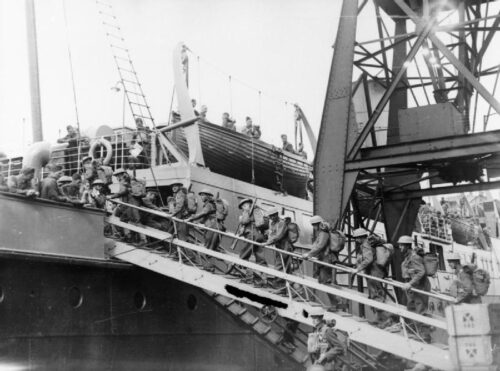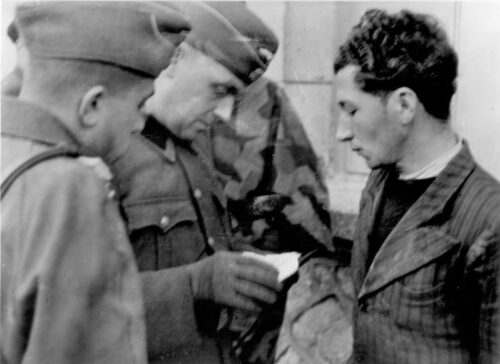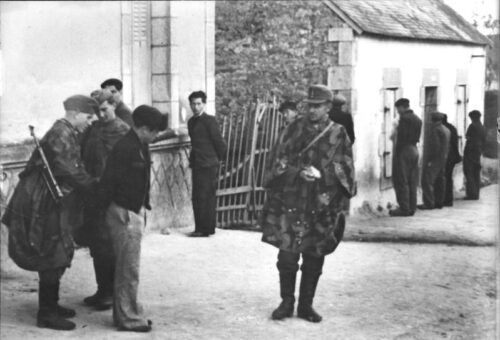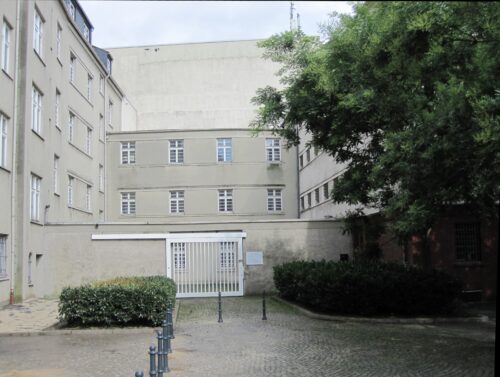An American officer and a French partisan in 1944. Photo: National Archives.
“Throughout France, the Resistance had been of inestimable value in the campaign. Without their great assistance, the liberation of France would have consumed a much longer time and meant greater losses to ourselves.” — Dwight D. Eisenhower.
Corporal Bruce Dowding was an Australian teacher who became a hero of the French Resistance and a secret agent for MI9, the British intelligence branch that specialized in escape and evasion. He was born in Melbourne in 1914, the youngest son of John McCallum Dowding and Margaret Kate Dowding (née Walsh). He was raised in the Presbyterian Church and had a passion for learning. He attended Glenhuntly State School before winning scholarships to Caulfield Grammar School and Wesley College, where he excelled in French and British history. He also gained registration as a teacher and studied French at the University of Melbourne.
In 1938, he left Australia for a year-long scholarship at the University of Sorbonne in Paris, where he immersed himself in French language and civilization. He traveled through the South Seas and Panama Canal to reach France and fell in love with the country and its culture. He decided to stay there even after the outbreak of World War II, despite the rising tensions in Europe. He wrote to his family that he would get out of harm’s way if war broke out, but he also felt a strong attachment to France and its people.
Dowding volunteered as an interpreter for the British army in Boulogne, where he was stationed during the Phoney War. The Phoney War was a period of relative inactivity in Western Europe during World War II, from September 1939 to May 1940. It was marked by a lack of major military operations by the Allies and the Axis, despite both sides being formally at war. The term “Phoney War” was coined by British journalists to mock the apparent absence of combat and the boredom of the soldiers.

Dowding was captured by the Nazis on 23 May 1940, when they attacked the town as part of their invasion of France. He was taken to a prisoner of war camp in Montargis, but he managed to escape by crawling through a sewer and hiding in a nearby forest. He then made his way to Marseille, where he met other escaped servicemen and civilians who were trying to flee from occupied France. He became involved in early attempts to exfiltrate them across the border to Spain or by sea to North Africa. He befriended Donald Caskie, Nancy Wake and Elisabeth Furse, who were also working for the same cause. He also met Varian Fry, Albert O. Hirschman and others who were part of the Emergency Rescue Committee, an American organization that helped prominent intellectuals, artists and writers, mostly Jewish, escape from Nazi persecution and reach the USA.
He soon came to the attention of MI9, the British intelligence branch that was responsible for escape and evasion operations in enemy territory. MI9 was formed by special charter on 23 December 1939 as a section of the Directorate of Military Intelligence. It had two principal tasks: assisting in the escape of Allied prisoners of war held by the Axis countries, especially Nazi Germany; and helping Allied military personnel, especially downed airmen, evade capture after they were shot down or trapped behind enemy lines in Axis-occupied countries. MI9 trained Allied soldiers and airmen in tactics for evading and escaping and helped prisoners of war to escape by establishing clandestine communications and providing escape devices to them. MI9 also gathered intelligence from escaped or evaded personnel through debriefing sessions.
He was recruited by Captain Ian Garrow, who was appointed as the leader of the Marseille-based escape and evasion organization, later known as the Pat O’Leary Line. The Pat O’Leary Line was one of many escape and evasion networks in France during World War II. Along with networks such as the Comet Line, the Shelburne Escape Line, and others, they are credited with helping thousands of Allied airmen and soldiers escape Nazi-occupied Western Europe during World War II. The Pat O’Leary Line received financial assistance from MI9.

Dowding became Garrow’s second-in-command and adopted the alias of “André Mason”. He managed the Marseille-Perpignan part of the line, which involved finding safe houses, arranging transport, providing false papers and liaising with local contacts. He also worked closely with a group of Spanish exiles in Toulouse, led by Francisco Ponzán Vidal, who provided guides to help servicemen cross the Pyrenees into Spain. The Pat O’Leary Line was one of the most successful escape routes of the war, helping more than 600 Allied servicemen and Jewish refugees reach safety.
The Pat O’Leary Line was named after Albert Guérisse, one of its early leaders who used “Pat O’Leary” as his pseudonym. Guérisse was a Belgian doctor who joined the British Royal Navy after escaping from France through Gibraltar. He posed as a Canadian officer to explain his accent and protect his family in Belgium if he was captured. He took over as Pat O’Leary after Garrow’s arrest in June 1941.
The Pat O’Leary Line had many volunteers or “helpers” who risked their lives to shelter, feed, clothe and escort Allied personnel across France. They included French civilians from different walks of life, such as farmers, priests, teachers, doctors and lawyers. They also included British, American and other Allied agents who operated undercover in France. Some of the most notable helpers were Nancy Wake, the “White Mouse” who became a leader of the Maquis; Harry Rée, a British schoolteacher who became a saboteur; and Mary Lindell, a British aristocrat who became a nurse.
Dowding spoke fluent French and Spanish and had a deep interest in music. He was admired by his colleagues for his courage, intelligence and dedication. He impressed Albert Guérisse, who described him as having “lived for years in the south of France, spoke perfect French, combined a deep interest in music with the physique of a policeman, and had become one of the most active and daring members of the organisation”. He also earned the respect and gratitude of many people he helped to escape, such as Frank Foley, a British spy who posed as a passport officer at the British embassy in Berlin.

Dowding had to deal with constant surveillance by the Gestapo and Vichy police, who were trying to infiltrate and dismantle the escape network. He had several narrow escapes from capture and had to change his appearance and identity frequently. He was eventually betrayed by Harold Cole, a British double agent who worked for the Gestapo. Cole had infiltrated the Pat O’Leary Line and informed on many of its members. Dowding was arrested on 18 December 1942 in Marseille along with several other agents. He was taken to Gestapo headquarters where he was tortured and interrogated for months. He refused to reveal any information or betray his comrades.
Dowding along with seven French nationals were tried by People’s Court of the Third Reich on 4 March 1943.The People’s Court of the Third Reich was a special court that dealt with crimes against Nazi Germany. It was established in 1934 by Adolf Hitler, who was dissatisfied with the regular courts. The president of the court, Roland Freisler, was a former Bolshevik prisoner of war who became a fanatical Nazi. The court was notorious for its harsh sentences, often death penalties, and its lack of fair trials. The defendants had no chance to defend themselves or consult lawyers and were often humiliated and shouted at by Freisler. The court was abolished in 1945 after the fall of Nazi Germany.
Dowding and the seven French nationals were accused of working “continuously and at times together” to harm the Reich’s war power, spy for the Allies, and help Allied servicemen. They received death sentences on 16 April 1943.They were moved to Dortmund prison on 29 June 1943. Dowding was executed by guillotine on 30 June 1943 and buried in an unmarked grave in Dortmund cemetery. He was 29 years old. His body was later relocated to the Reichswald Forest War Cemetery near Kleve.

Dowding saved thousands of lives and contributed to the Allied victory. He was posthumously recommended for the King’s Commendation for Brave Conduct by Britain for his “gallant and distinguished services in the field”. He was also nominated for the Croix de Guerre and the Légion d’honneur by France, but his home country of Australia did but the Australian authorities did not support this proposal. They argued that Dowding was not an Australian soldier and did not follow up on the request. Today, more than 70 years later, the Australian position remains unchanged. Dowding’s name is one of the many that are honored in the Steinwache memorial museum in Dortmund, which was opened in 1992 to commemorate the victims of Nazism.
*The views and opinions expressed on this website are solely those of the original authors and contributors. These views and opinions do not necessarily represent those of Spotter Up Magazine, the administrative staff, and/or any/all contributors to this site.
